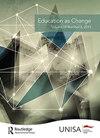新冠肺炎时期美国高等教育机构身份建构的语言景观
IF 1
4区 教育学
Q3 EDUCATION & EDUCATIONAL RESEARCH
引用次数: 2
摘要
本研究考察了自2019冠状病毒病大流行以来,美国中西部一所大学的语言景观如何发生变化,以及这种变化如何在话语上构建了大学及其社区的身份。重点在于新显示的符号学,它提供了防止病毒传播的信息。本研究通过分析传单、海报、横幅等与新冠肺炎相关的公共标志,发现了机构和社区表达身份和声音的五种方式。大学的身份已经转变为一个代理人,鼓励团结一致,保护自己和社区;关心社区成员的有爱心的实体;社区成员声音表达的网站;将互动从实体话语扩展到网络话语的空间创造者;也是社区国际成员的信息传递者。这项研究呼吁对全球大流行对语言格局的影响进行调查。本文章由计算机程序翻译,如有差异,请以英文原文为准。
The Linguistic Landscape as an Identity Construction Site of a United States’ Higher Educational Institution in the Time of COVID-19
This study examines how the linguistic landscape of a university in the midwestern United States has changed since the COVID-19 pandemic, and how that change has discursively constructed the identities of the university and its community. The focus lies in the newly displayed semiotics that provides information about preventing the virus from spreading. By analysing public signs such as flyers, posters, and banners whose contents have to do with COVID-19, this study found the following five ways in which the institution and community express their identities and voices. The university’s identity has shifted to that of an agent that acts to encourage a united effort to protect itself and its community; a caring entity that cares about community members; a site for community members’ voice expression; a space creator to expand interaction from physical to online discourses; and an information deliverer for international members of the community. This study calls for research that investigates the global pandemic’s influence on the linguistic landscape.
求助全文
通过发布文献求助,成功后即可免费获取论文全文。
去求助
来源期刊

Education As Change
EDUCATION & EDUCATIONAL RESEARCH-
CiteScore
1.40
自引率
0.00%
发文量
29
审稿时长
24 weeks
期刊介绍:
Education as Change is an accredited, peer reviewed scholarly online journal that publishes original articles reflecting critically on issues of equality in education and on the ways in which educational practices contribute to transformation in non-formal, formal and informal contexts. Critique, mainly understood in the tradition of critical pedagogies, is a constructive process which contributes towards a better world. Contributions from and about marginalised communities and from different knowledge traditions are encouraged. The articles could draw on any rigorous research methodology, as well as transdisciplinary approaches. Research of a very specialised or technical nature should be framed within relevant discourses. While specialised kinds of research are encouraged, authors are expected to write for a broader audience of educational researchers and practitioners without losing conceptual and theoretical depth and rigour. All sectors of education are covered in the journal. These include primary, secondary and tertiary education, adult education, worker education, educational policy and teacher education.
 求助内容:
求助内容: 应助结果提醒方式:
应助结果提醒方式:


